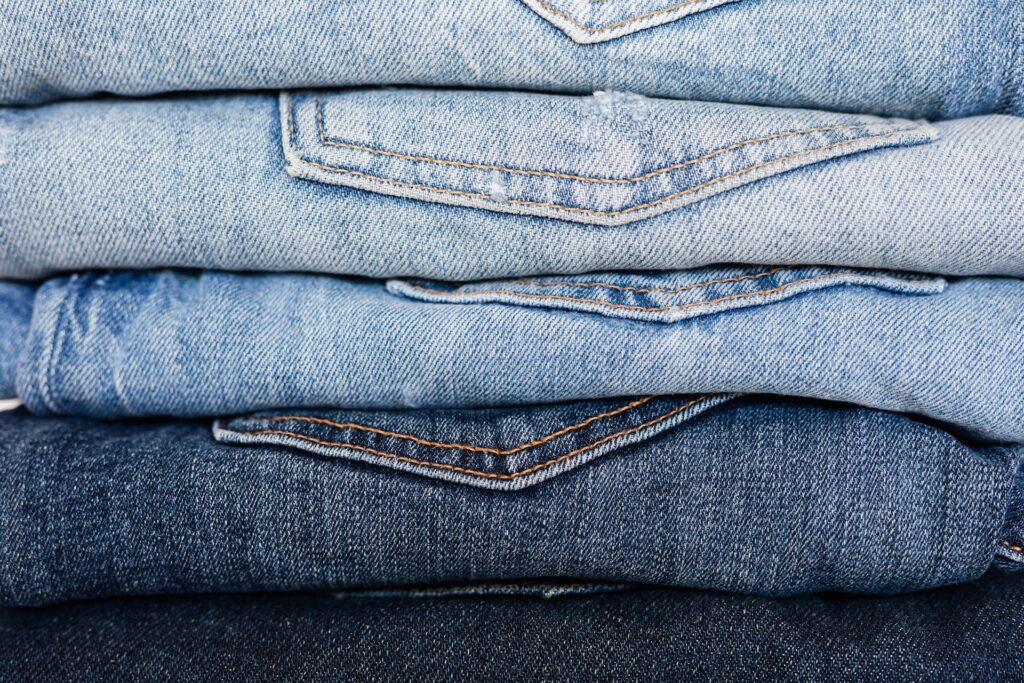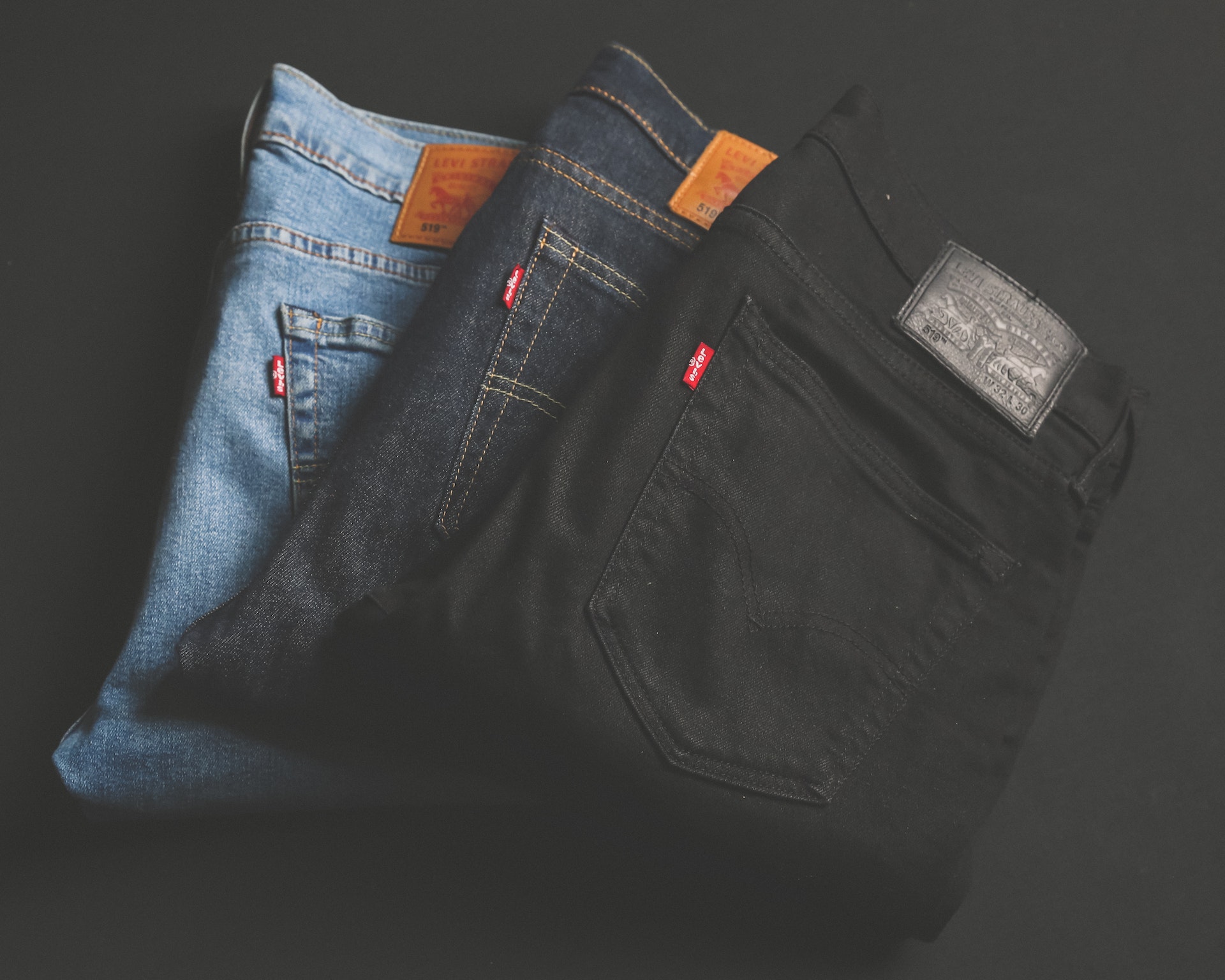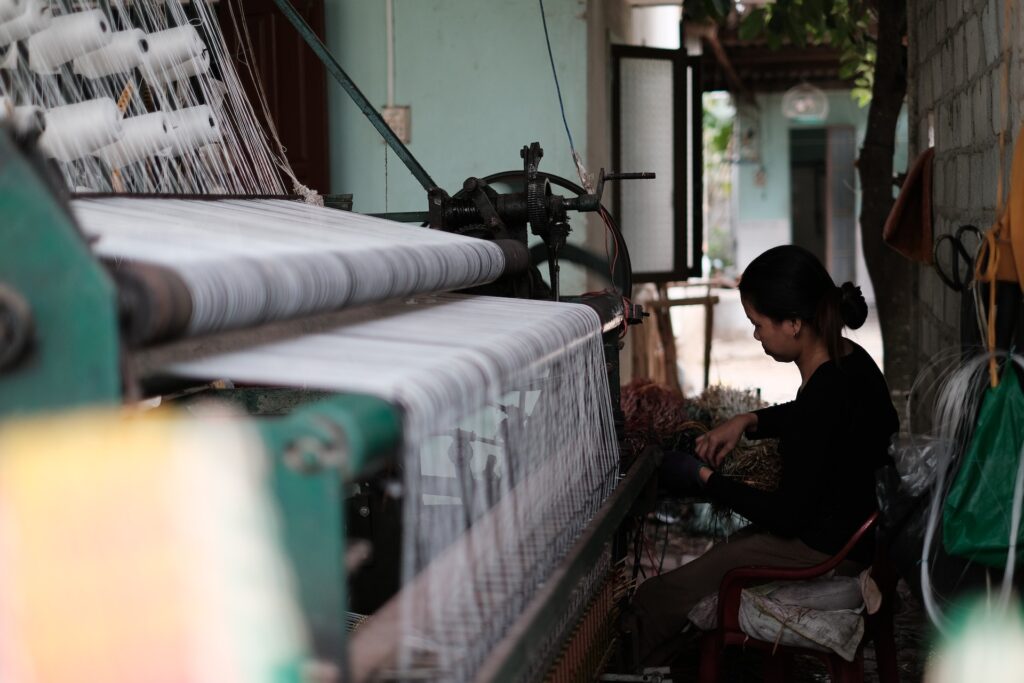A Brief History Of Denim

Stack of denim
The Start
As a fashion designer, I’m excited to talk to you about one of the most iconic fabrics in fashion history – denim. Denim is a sturdy cotton fabric that is characterized by its twill weave, which creates a diagonal ribbing pattern as mentioned above.
This fabric has a rich history that dates back to the 18th century and has evolved into one of the most versatile materials in the fashion industry.
Denim was originally produced in the French town of Nîmes, where it was known as “serge de Nîmes.” However, it was the American entrepreneur Levi Strauss who popularized denim in the mid-19th century by using it to make durable workwear, including the now-iconic blue jeans. Over time, denim has become a staple fabric in fashion, appearing in everything from jackets to dresses to furniture.
Denim comes in a variety of weights and thicknesses, which can affect its durability, comfort, and versatility.
Denim is a versatile and durable fabric that has been an essential part of the fashion industry for many years. Its history can be traced back to the 16th century when it was first produced in France. The production process has evolved over the years, and today, most denim is produced using automated looms. Denim fabric comes in various weights and thicknesses, and it can be used for a variety of clothing items
The history of denim can be traced back to the 16th century when it was first produced in the city of Nimes, France.
The fabric was originally called serge de Nimes, which later became shortened to denim. The fabric was initially used to make sturdy work clothes for laborers, such as farmers, miners, and cowboys. The fabric’s durability and strength made it the perfect material for tough jobs. The production process for denim has evolved over the years. Originally, denim was made from a mixture of cotton and wool, and the fabric was handwoven. In the 18th century, the first industrial looms were developed, which made it possible to produce denim fabric on a larger scale.
Today, most denim is produced using automated looms, which produce a consistent fabric.
Denim fabric comes in various weights and thicknesses. The weight of denim is measured in ounces per square yard, and it ranges from 4-16 ounces. The heavier the fabric, the more durable and rigid it is. The most common weight for denim fabric used in jeans is around 12-14 ounces. Lighter weight denim is often used for shirts and dresses, while heavier weight denim is used for jackets and furniture.

Levi’s
Denim fabric can be used for a variety of clothing items, including jeans, jackets, shirts, and dresses. It is also used in home décor, such as furniture and curtains. Denim has become an essential part of the fashion industry, and many designers have incorporated it into their collections. Some of the most famous denim brands include Levi’s, Wrangler, and Lee.
Levi’s is one of the most iconic denim brands in the world. The company was founded in 1853 and is known for its classic denim jeans. The company’s original design was the 501 jeans, which were made for gold miners during the California Gold Rush. Today, Levi’s offers a range of denim products, including jackets, shirts, and dresses.
Another well-known denim brand is Wrangler. The company was founded in 1947 and is known for its rugged and durable jeans. Wrangler’s jeans are designed for cowboys and those who work outdoors. The company also offers a range of denim jackets, shirts, and accessories.
Lee is another popular denim brand that was founded in 1889. The company is known for its innovative designs, such as the zip-fly jeans, which were introduced in
1926. Today, Lee offers a range of denim products, including jeans, jackets, and shirts.
In recent years, many fashion brands have experimented with denim and incorporated it into their collections. For example, Gucci has incorporated denim into its designs, offering denim jackets, shirts, and dresses. Saint Laurent has also incorporated denim into its collections, with denim jackets and jeans. Additionally, luxury fashion brand Balmain has included denim in its collections, with high-end denim jackets and jeans.
Diesel
Diesel is an Italian fashion brand that is known for its high-end denim products. The brand was founded in 1978 by Renzo Rosso and quickly gained a reputation for its innovative designs and high-quality fabrics. Today, Diesel is one of the most well-known denim brands in the world, and is recognized for its edgy, urban style.
One of the ways that Diesel sets itself apart in the denim market is through its use of advanced production techniques. The brand uses a combination of traditional and modern methods to create its jeans, starting with the selection of high-quality raw materials. Diesel sources its denim from some of the best mills in the world, and carefully selects each batch of fabric to ensure consistency and quality.
Once the denim has been selected, it is then treated with a range of innovative techniques to create unique washes and finishes. Diesel is known for its vintage-inspired washes, which are achieved through a combination of sandblasting, scraping, and other techniques. The brand also uses laser technology to create distressed and faded effects, giving its jeans a unique, lived-in look.
Check out our blog about Diesel – The Rise and Rise of Diesel: An Iconic Italian Fashion Brand
Replay
Replay is another Italian fashion brand that specializes in denim. The brand was founded in 1978 by Claudio Buziol, and has since become known for its high-quality denim products and innovative production methods.
Like Diesel, Replay places a strong emphasis on the quality of its raw materials. The brand sources its denim from some of the best mills in the world, and carefully selects each batch of fabric to ensure consistency and durability. Once the denim has been selected, it is then treated with a range of unique techniques to create interesting washes and finishes. Replay is known for its vintage-inspired washes, which are achieved through a combination of hand scraping, brushing, and other techniques. The brand also uses laser technology to create distressed and faded effects, giving its jeans a unique, lived-in look.
In addition to its innovative production techniques, Replay is also committed to sustainability. The brand uses eco-friendly materials and processes whenever possible, and has implemented a range of initiatives to reduce its environmental impact.
Overall, Diesel and Replay are both known for their innovative production methods and high-quality denim products. Each brand has its own unique style and approach to denim, but both share a commitment to using the best materials and techniques to create jeans that are both stylish and durable.
Tramarossa
Tramarossa is known for their high-quality denim production, which is done entirely in Italy using premium materials and traditional Italian craftsmanship techniques. They use a variety of denim types and weights, including:
Raw Denim – This is a type of denim that is not pre-washed or treated in any way before it is sold. It is typically stiff and dark in colour, and develops unique fades and creases over time as the wearer breaks it in.
Selvedge Denim – This is a type of denim that is woven on old-fashioned shuttle looms, which create a self-finished edge on the fabric that prevents fraying. Selvedge denim is known for its durability and unique texture, and is often used in high-end denim production.
Stretch Denim – This is a type of denim that contains a small amount of spandex or elastane, which gives it a bit of stretch and allows for a more comfortable and flexible fit.
Tramarossa uses all of these types of denim in their production, and sources their denim exclusively from top Italian mills such as Candiani and Berto. They are known for their attention to detail in selecting the perfect denim for each of their styles, and their commitment to using only the highest-quality materials in their jeans

Lady hard at work on the loom
Blending And Weights
As a fashion designer, I’m excited to talk to you about one of the most iconic fabrics in fashion history – denim. Denim is a sturdy cotton fabric that is characterized by its twill weave, which creates a diagonal ribbing pattern as mentioned above.
This fabric has a rich history that dates back to the 18th century and has evolved into one of the most versatile materials in the fashion industry.
Denim was originally produced in the French town of Nîmes, where it was known as “serge de Nîmes.” However, it was the American entrepreneur Levi Strauss who popularized denim in the mid-19th century by using it to make durable workwear, including the now-iconic blue jeans. Over time, denim has become a staple fabric in fashion, appearing in everything from jackets to dresses to furniture.
Denim comes in a variety of weights and thicknesses, which can affect its durability, comfort, and versatility.
Here are some common weights of denim:
Lightweight denim (less than 12 oz) – This type of denim is soft and comfortable, making it a good choice for shirts and dresses. However, it may not be as durable as heavier weights.
Midweight denim (12-16 oz) – This is the most common weight of denim and is used for a variety of garments, including jeans, jackets, and skirts. It strikes a balance between durability and comfort.
Heavyweight denim (over 16 oz) – This type of denim is extremely durable and is often used for workwear and heavy-duty jeans. However, it can be stiff and uncomfortable to wear.
Denim can also be blended with a variety of other materials to improve its durability or softness. Here are some common materials that can be blended with denim:
Spandex – This elastic material can be added to denim to create stretch denim, which is popular for its comfort and flexibility. The addition of spandex can also improve the durability of the denim, as it helps to prevent the fabric from tearing or wearing out.
Polyester – This synthetic material can be blended with denim to make it more durable and resistant to wrinkles. Polyester is also lightweight and quick-drying, making it a popular choice for denim jackets and other outerwear.
Rayon – This semi-synthetic material can be blended with denim to create a softer and more comfortable fabric. Rayon is also breathable, making it a good choice for denim shirts and dresses.
Wool – This natural material can be blended with denim to create a warmer and more insulating fabric. Wool is also moisture-wicking, making it a good choice for denim jackets and other outerwear.
Silk – This natural material can be blended with denim to create a softer and more luxurious fabric. Silk is also moisture-wicking, making it a good choice for denim dresses and skirts. Blending denim with these materials can help to create fabrics that are more versatile and comfortable, while still maintaining the durability and ruggedness that denim is known for.
Several fashion brands and companies have made a name for themselves using denim. Levi’s, the company that popularized blue jeans, is still one of the most iconic denim brands in the world. Other notable denim brands include Wrangler, Lee, and Diesel. In recent years, high-end fashion designers such as Gucci, Prada, and Balenciaga have also incorporated denim into their collections, using the fabric in unexpected ways such as tailored blazers and evening gowns.
Denim has also been used in furniture design, with designers creating sofas, chairs, and even ottomans upholstered in denim. This has helped to create a more relaxed and casual atmosphere in homes and public spaces.
